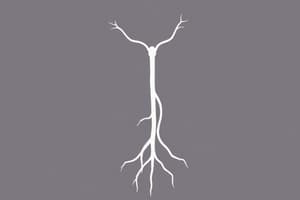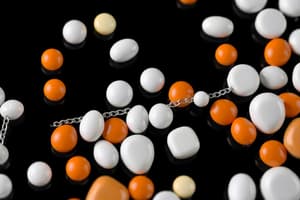Podcast
Questions and Answers
What is the primary mechanism of action for atropine regarding M receptors?
What is the primary mechanism of action for atropine regarding M receptors?
- It enhances the action of ACh at the receptor sites.
- It binds irreversibly to M receptors.
- It competitively blocks ACh and other cholinergic agonists. (correct)
- It activates N receptors selectively.
Which of the following statements about atropine's selectivity is true?
Which of the following statements about atropine's selectivity is true?
- Atropine primarily targets the M1 subgroup of muscarinic receptors.
- Atropine is equally potent at M and N receptors.
- Atropine is highly selective for M receptors with low potency at N receptors. (correct)
- Atropine has a higher affinity for N receptors than M receptors.
What physiological effect does atropine have on the eye?
What physiological effect does atropine have on the eye?
- Causes constriction of the pupils.
- Results in persistent mydriasis and cycloplegia. (correct)
- Leads to increased secretion of tears.
- Improves near vision by enhancing ciliary muscle activity.
How can the effects of atropine be overcome?
How can the effects of atropine be overcome?
Which muscarinic effects are specifically blocked by atropine?
Which muscarinic effects are specifically blocked by atropine?
What is a primary use of atropine in conjunction with neostigmine?
What is a primary use of atropine in conjunction with neostigmine?
Which of the following is a common adverse effect of atropine poisoning?
Which of the following is a common adverse effect of atropine poisoning?
What distinguishes scopolamine from atropine in terms of physiological effects?
What distinguishes scopolamine from atropine in terms of physiological effects?
Why is the use of atropine for inducing mydriasis and cycloplegia in older individuals considered risky?
Why is the use of atropine for inducing mydriasis and cycloplegia in older individuals considered risky?
How does atropine's elimination in the body occur?
How does atropine's elimination in the body occur?
What is the primary mechanism of action of muscarinic cholinoreceptor antagonists?
What is the primary mechanism of action of muscarinic cholinoreceptor antagonists?
Which agent is commonly classified as an antimuscarinic drug?
Which agent is commonly classified as an antimuscarinic drug?
What effect do muscarinic cholinoreceptor antagonists primarily block?
What effect do muscarinic cholinoreceptor antagonists primarily block?
What is a common therapeutic use of antimuscarinic agents?
What is a common therapeutic use of antimuscarinic agents?
Why are ganglionic blockers not widely used in clinical practice?
Why are ganglionic blockers not widely used in clinical practice?
What is the primary effect of atropine at therapeutic doses?
What is the primary effect of atropine at therapeutic doses?
Which of the following is NOT a type of cholinergic antagonist mentioned?
Which of the following is NOT a type of cholinergic antagonist mentioned?
Which areas of the body are most sensitive to the effects of atropine?
Which areas of the body are most sensitive to the effects of atropine?
Which neuromuscular blocking agent is least selective in causing ganglionic blockade?
Which neuromuscular blocking agent is least selective in causing ganglionic blockade?
What is the primary therapeutic use of neuromuscular blocking agents during surgery?
What is the primary therapeutic use of neuromuscular blocking agents during surgery?
Which neuromuscular blocker is primarily degraded by spontaneous plasma hydrolysis?
Which neuromuscular blocker is primarily degraded by spontaneous plasma hydrolysis?
What is a major side effect from the release of histamine triggered by neuromuscular blocking agents?
What is a major side effect from the release of histamine triggered by neuromuscular blocking agents?
What characteristic do all neuromuscular blocking agents share regarding their administration?
What characteristic do all neuromuscular blocking agents share regarding their administration?
Which of the following is preferred for controlling muscle spasms rather than neuromuscular blockers?
Which of the following is preferred for controlling muscle spasms rather than neuromuscular blockers?
Which agent is known to cause the release of histamine that may provoke seizures due to its metabolite?
Which agent is known to cause the release of histamine that may provoke seizures due to its metabolite?
Which neuromuscular blocker is known for having a vagolytic action that can lead to tachycardia?
Which neuromuscular blocker is known for having a vagolytic action that can lead to tachycardia?
What effect does ganglionic blockade primarily have on blood pressure?
What effect does ganglionic blockade primarily have on blood pressure?
Which condition may be exacerbated by ganglionic blockade in males?
Which condition may be exacerbated by ganglionic blockade in males?
Which neuromuscular blocker is known for causing complete muscle relaxation during surgery?
Which neuromuscular blocker is known for causing complete muscle relaxation during surgery?
Which substance is primarily affected by nondepolarising neuromuscular blockers?
Which substance is primarily affected by nondepolarising neuromuscular blockers?
What is a common clinical application of mecamylamine?
What is a common clinical application of mecamylamine?
What occurs in the gastrointestinal tract as a result of ganglionic blockade?
What occurs in the gastrointestinal tract as a result of ganglionic blockade?
Which of the following drugs acts peripherally by interfering with calcium release from muscle cells?
Which of the following drugs acts peripherally by interfering with calcium release from muscle cells?
Which outcome is expected after a ganglionic blockade regarding heart rate?
Which outcome is expected after a ganglionic blockade regarding heart rate?
What does the term 'curare' refer to?
What does the term 'curare' refer to?
Which characteristic describes depolarizing neuromuscular blockers?
Which characteristic describes depolarizing neuromuscular blockers?
Flashcards are hidden until you start studying
Study Notes
Cholinergic Antagonists:
- Cholinergic antagonists are drugs that block the effects of acetylcholine (ACh) at cholinergic receptors.
- They are divided into antimuscarinic (M receptor blockers) and antinicotinic (Nicotinic receptor blockers).
- Most clinically useful are antimuscarinic agents and neuromuscular blocking agents.
- Ganglionic blockers have limited clinical usefulness due to their broad actions and lack of selectivity.
Antimuscarinic Agents:
- Antimuscarinic agents, also called parasympatholytics, block the effects of parasympathetic autonomic discharge.
- They competitively bind to M cholinergic receptors, inhibiting ACh’s stimulatory effects.
- They also block some sympathetic neurons that are cholinergic, like those innervating salivary and sweat glands.
- Antimuscarinic agents are beneficial in various clinical situations.
- They do not block N cholinergic receptors, therefore they lack skeletal neuromuscular or autonomic ganglia effects.
Atropine:
- Atropine is a tertiary amine alkaloid ester of tropic acid.
- It is found in plants like Atropa belladonna and Datura stramonium.
- At therapeutic doses, atropine acts mainly peripherally, with minimal CNS effects.
- Tissues most sensitive to atropine are salivary, bronchial, and sweat glands.
- Atropine's duration of action is around 4 hours, but its effects in the eye can last for days.
Atropine - MOA:
- Atropine and its related compounds have a higher affinity for M receptors.
- They bind competitively to the common site on cholinergic receptors, blocking ACh and other cholinergic agonists.
- Atropine's blockade can be overcome by increasing the concentration of ACh or using a muscarinic agonist.
- Atropine is highly selective for M receptors, with much lower potency at N receptors, but does not discriminate between M1, M2, and M3 receptors.
Atropine – Physiological Actions:
- Eye: Atropine blocks cholinergic activity of the pupillary sphincter muscles and ciliary muscles, causing mydriasis (dilated pupil), unresponsiveness to light, cycloplegia (paralysis of ciliary muscles), and inability to focus for near vision.
- Antisecretory agent: Used to block secretions in the respiratory tract prior to surgery.
- Anaesthesia: Used with neostigmine to reverse skeletal muscle relaxation after surgery.
Atropine - PK:
- Atropine is readily absorbed from the GIT and the conjuctival membrane, and well distributed throughout the body, including the CNS.
- It is partially metabolized by the liver with a plasma half-life of 2-4 hours.
- Its effects on parasympathetic function decline rapidly in all organs except the eye.
- About 60% of the dose is eliminated unchanged in the urine.
Atropine - A/E:
- Poisoning manifests as dry mouth, blurred vision, tachycardia, hot & flushed skin, urinary retention, and constipation.
- Body temperature is often elevated.
- CNS effects include restlessness, confusion, hallucinations, delirium, depression, circulatory/respiratory collapse, and death.
- Atropine's use for mydriasis and cycloplegia in older individuals is risky due to potential glaucoma exacerbation.
Scopolamine:
- Scopolamine is another belladonna alkaloid with peripheral effects similar to atropine, but has greater CNS action and a longer duration of action.
Scopolamine – Physiological Actions:
- Scopolamine has marked central effects, producing drowsiness and amnesia (loss of short-term memory) at therapeutic dosages.
Ganglionic Blockers:
- Ganglionic blockers act by blocking the transmission of nerve impulses through autonomic ganglia.
- They have limited clinical usefulness due to their diffuse actions and lack of selectivity.
- Examples include trimethaphan, mecamylamine, hexamethonium, and tetraethylammonium.
Cardiovascular Effects of Ganglionic Blockade:
- Decreased arteriolar and venous tone, leading to a gradual decrease in BP.
- Moderate tachycardia may occur due to decreased parasympathetic dominance at the sinoatrial node.
Other Organ System Effects of Ganglionic Blockade:
- GIT: Reduced secretions and profound inhibition of motility, potentially causing constipation.
- Genitourinary: Ganglionic blockade can precipitate urinary retention in men with prostatic hyperplasia.
- Sexual functions: Impaired erection and ejaculation.
- Thermoregulatory sweating is blocked.
Clinical Application of Ganglionic Blockers:
- Rarely used due to the availability of selective autonomic blocking agents.
- Mecamylamine has been studied for use in reducing nicotine craving, treating moderate to severe hypertension, and as an alternative therapy for hypertensive crises.
- Trimethaphan is occasionally used in the treatment of hypertensive crises.
Neuromuscular Blocking Drugs:
- These drugs block cholinergic transmission at the neuromuscular junction of skeletal muscle, resulting in muscle relaxation.
- They are divided into nondepolarising (competitive) blockers and depolarizing blockers.
- Clinically useful during surgery to achieve muscle relaxation.
- Other muscle relaxants include centrally acting agents like diazepam and baclofen, and peripherally acting agents like dantrolene and botulinum toxin.
Nondepolarising (Competitive) Blockers:
- They act by competitively binding to the N receptors at the neuromuscular junction, blocking the action of ACh.
- Examples include curare, tubocurarine, pancuronium, mivacurium, metocurine, doxacurium, vecuronium, and rocuronium.
- They have variable potencies in producing ganglionic blockade, with tubocurarine being the least selective.
- Some, like pancuronium, have vagolytic action due to muscarinic receptor blockade and lead to tachycardia.
Therapeutic Uses of Nondepolarising Blockers:
- Used as adjuvant drugs to relax skeletal muscle during surgery and orthopedic procedures.
- Employed in procedures like intubation, bronchoscopy, and esophagoscopy.
- Used in psychiatry to prevent trauma during electroconvulsive therapy (ECT).
- Control of muscle spasms – botulinum toxins are preferred.
PK of Nondepolarising Blockers:
- All are injected IV due to poor oral absorption.
- They penetrate membranes poorly and do not enter cells or cross the BBB.
- Most are excreted unchanged in the urine.
- Atracurium is degraded spontaneously in plasma and by ester hydrolysis.
- Atracurium has been replaced by cisatracurium due to histamine release and laudanosine formation, which can cause seizures.
- Vecuronium and rocuronium are deacetylated in the liver, with prolonged clearance in patients with hepatic disease.
Drug Interactions:
- Cholinesterase Inhibitors: These drugs increase ACh concentrations, potentially overcoming neuromuscular blockade. Examples include neostigmine and pyridostigmine.
- Antibiotics: Some antibiotics can potentiate neuromuscular blockade. Examples include aminoglycosides (e.g., gentamicin) and macrolides (e.g., erythromycin).
- Anesthetics: Volatile anesthetics can enhance neuromuscular blockade.
- Other Drugs: Diuretics, lithium, and corticosteroids can also increase the effects of nondepolarising blockers.
Depolarizing Blockers:
- They cause depolarisation of the muscle membrane, initially leading to a brief period of muscle twitching followed by paralysis.
- The main example is succinylcholine.
- Short duration of action and rapid onset.
- Used for rapid intubation, and in combination with non-depolarizing agents to prolong paralysis.
Depolarising Blockers – MOA:
- Succinylcholine binds to the N receptors at the neuromuscular junction, mimicking ACh and causing a prolonged depolarization.
- This prolonged depolarization prevents further ACh binding, resulting in paralysis.
PK of Depolarizing Blockers
- Rapidly hydrolyzed by plasma cholinesterase.
- Short duration of action.
- Has a phase I (depolarizing) and phase II (desensitisation) effect.
- Metabolic breakdown is affected by atypical cholinesterase activity.
A/E of Depolarizing Blockers
- Hyperkalemia.
- Malignant hyperthermia.
- Rhabdomyolysis.
- Muscle pain.
- Cardiovascular effects (bradycardia).
Interactions of Depolarizing Blockers
- Cholinesterase inhibitors can prolong the effects of succinylcholine.
- Antibiotics may enhance the effects.
- Anesthetics may influence the effect.
- Other drugs may interact.
Adverse Effects of Antimuscarinic Agents:
- Dry mouth, blurred vision, photophobia, tachycardia, urinary retention, constipation, CNS effects (restlessness, confusion, hallucinations, delirium), and hyperthermia.
- Contraindications include narrow-angle glaucoma, urinary retention, and megacolon.
Adverse Effects of Neuromuscular Blocking Agents:
- Respiratory depression, muscle weakness, and prolonged paralysis.
- Contraindications include myasthenia gravis, and hypersensitivity.
Studying That Suits You
Use AI to generate personalized quizzes and flashcards to suit your learning preferences.




